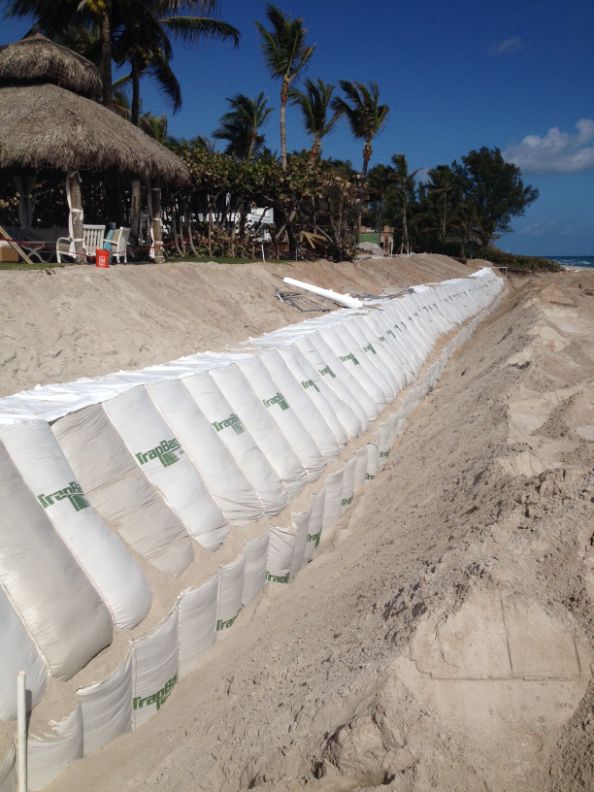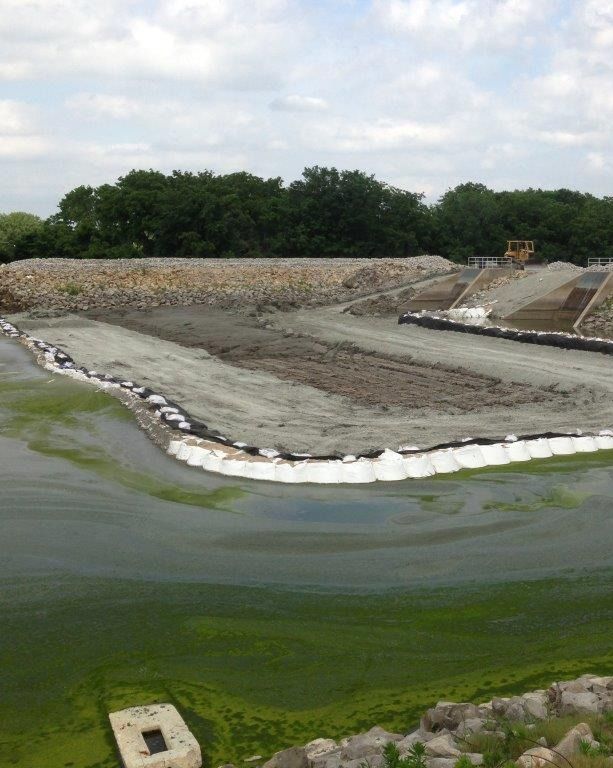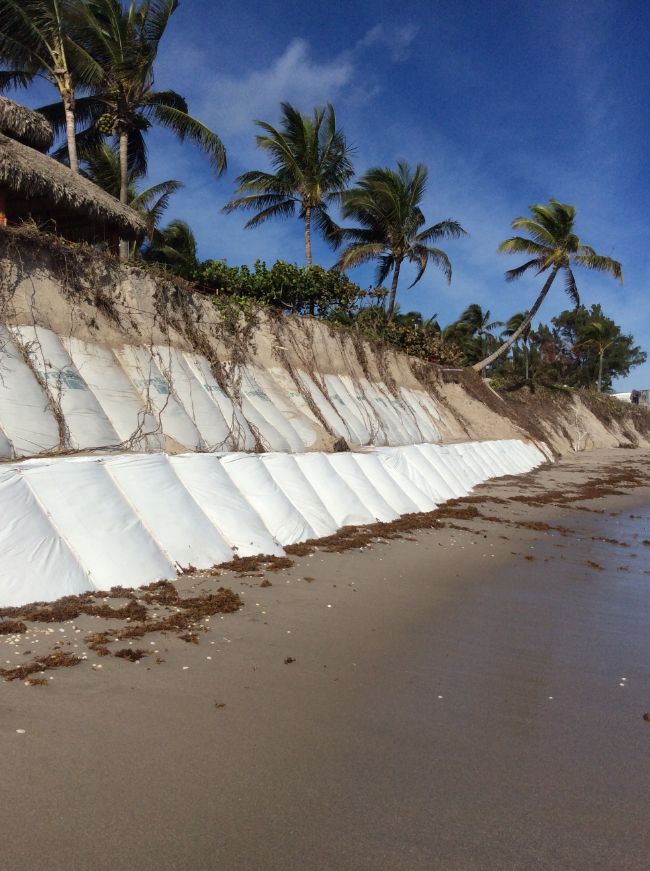Combat Coastal Erosion & Invest in Coastal Construction

Coastal erosion is a prevalent and expensive issue. It is estimated that the U.S. sees over $500 million in property losses every year due to coastal erosion, and some coastal regions are experiencing an average loss of 25–50 feet of coastal land every year.
The services that coastal engineers provide are critical to ensuring the structural integrity of coastal regions is maintained and protected, providing ample space for communities to survive and thrive for many years to come. Preventing the erosion of coastal areas with some form of dependable flood barriers is important for the ecological environment, critical infrastructure, and commercial and residential properties of coastal communities.
TrapBag barriers can be used by coastal engineers to combat coastal erosion—when it comes to protecting coastlines from weakening and receding, they are the superior method. TrapBags are leakproof, extremely durable, quickly deployable barriers that provide a cost-effective alternative to more expensive forms of erosion control.
TrapBags for Coastal Construction
In addition to preventing coastal erosion, coastal engineers are often involved in construction projects that occur in or near bodies of water. These builds are typically more complicated than those on dry land, and as such, specialized forms of water barriers and control methods are required to assist in certain aspects of the construction process.
TrapBags can be utilized in coastal construction engineering projects, including:
- Water construction: Harbors, marinas, docks, and piers are all projects that require the expertise of coastal engineers. TrapBags can form a variety of water barriers and retaining walls to aid in the construction of these projects, including cofferdams.
- Seawall alternatives: Seawalls are necessary to protect people and property from dangerous flooding events. It is imperative that these structures are incredibly durable and leakproof, and coastal engineers are often brought in to assess the complexity of a project. TrapBags make cost-effective seawall alternatives, providing long-lasting protection in the event of hurricanes or tropical storms.
- Infrastructure protection: Municipalities spend huge amounts of money on constructing critical infrastructure to ensure their communities are properly served. Coastal towns need to have methods in place to protect these essential services and structures from damaging floods. Engineers are often brought in on these projects, saving municipal entities tons of money in reparative costs.
Advantages of Using TrapBag
TrapBags provide a durable coastal erosion control solution for coastal engineers for a variety of projects, as they are:
- Extremely efficient: TrapBags are not only superior to sandbags in performance when it comes to protecting communities from floods and coastal erosion, but they are also more cost-effective. TrapBags use 40% less fill than traditional sandbags—a single 100-ft. section of 4-ft.-high TrapBags replaces around 8,000 sandbags. This means less time spent on installation as well as greater savings.
- Easy to install: Many forms of flood protection, like massive boulders or sheet pile seawalls, require heavy machinery to be properly installed. This increases the time and money spent on the projects. TrapBags, however, can be placed and filled with a small crew in a manner of hours, depending on the size of the area in need of protection.
- Quick to deploy: TrapBags have been engineered in a way that makes them fast-acting, an important characteristic when the project is time-sensitive. The interconnected, accordion-style structure of TrapBag barriers makes them incredibly quick to place around structures of all shapes and sizes, roads, seawalls, riverbanks, and coasts, a necessary feature of reliable flood protection.
- Versatile: TrapBag barriers can create many kinds of structures, as well as be filled with a variety of substances—sand, concrete, and washed gravel can all be used to fill TrapBags, fitting whatever your project needs. TrapBags are the superior choice for coastal engineers creating dams, levees, diversion barriers, or seawalls.
Engineering for Climate Change: Warming Waters Impact Coastal Engineering Projects
Climate change is causing sea levels to rise and natural disasters to increase in frequency and intensity. The work of coastal engineers is becoming even more essential to coastal communities, and TrapBags are the best solution for the many climate change-related problems engineers will encounter.
TrapBags as Flood Protection

Coastal engineers may be tasked with protecting municipalities from the effects of flooding caused by natural disasters. TrapBags can be arranged in many different configurations to accommodate these needs.
Dams
Dams are water barriers that have water on both sides. As such, these must be incredibly durable, sturdy, and tall enough to prevent overflow. Dams contain floodwaters by slowing or completely stopping the flow of water. If compromised, the contained water can severely impact the surrounding environment, potentially claiming lives but certainly worsening erosion and harming infrastructure.
TrapBag barriers can be utilized by coastal engineers seeking to create dams. By filling TrapBags with concrete, permanent, affordable dams can be erected. For construction purposes, TrapBag dams can provide temporary stabilization to existing dams in the event one is at risk of being compromised.
Dikes
Dikes are embankments that run parallel to water sources. Coastal engineers may use these structures to keep usable land that would typically be under sea level from being overtaken by floodwaters. Because they hold back water that would compromise land, dikes enable more areas to be utilized for commercial and agricultural purposes.
Coastal engineers can ensure their projects provide the utmost protective guarantee when using TrapBag barriers. These flood bags are engineered to maintain integrity as a whole, even if one single cell is compromised. TrapBags can also be easily stacked on top of each other in the event water levels are expected to increase.
Levees
Tropical storms and heavy rains can cause floodwaters to overtake roads, farmland, neighborhoods, bridges, etc., leaving immense, costly destruction for municipalities to deal with later. Coastal engineers can help mitigate the physical and financial losses associated with these storms by creating long-lasting levees.
Levees are walls laid alongside water sources to prevent rising water levels from infiltrating surrounding communities. When placed along rivers, lakes, or coasts, levees can greatly protect areas and save lives, money, and time. TrapBags can make reliable levees on their own or be stacked onto existing levees, providing a few extra feet of sturdy protection when water levels continue to rise.
Seawalls
As many traditional types of seawalls are expensive, difficult to install, and can exacerbate the erosion of the installation site, coastal engineers may be looking for a superior solution. Seawall alternatives made of TrapBag barriers are durable, affordable, and quick to deploy forms of coastal protection.
Unlike some forms of seawalls, like sheet metal piling, TrapBag barriers do not penetrate the ground, ensuring the existing land is left intact and less susceptible to eroding in the future—make your seawall engineering more simple and effective with TrapBags.
TrapBags as Erosion Control

Coastal engineers play a large role in the protection of coastal environments from erosion due to natural disasters. This serves to maintain the economic and aesthetic value of coastal communities. TrapBags are extremely versatile and can be utilized to protect both natural and manmade structures from harm by creating forms for:
- Coastal stabilization: Stabilizing coasts is crucial for maintaining sturdy surfaces for commercial and residential investors to utilize. If a coastline starts to become degraded, land can significantly decrease in value, hurting the economic standing of a community.
- Dune stabilization: Dunes act as natural erosion barriers, slowing down the naturally occurring erosion caused by wind, rain, and changing tides. Without fully intact dunes, a shoreline can increasingly suffer and wither away. When placed in the center and base of dunes, TrapBags provide durable protection against the elements.
- Infrastructure protection: Eroding land can have an enormously negative impact on critical infrastructure located on or near coasts. Coastal engineers play a large role in determining how to safely protect these important and costly structures—TrapBags can help simplify the process. Whether you need a permanent erosion protection solution or are seeking a temporary fix while in the designing phase, TrapBag barriers are ready to be deployed to your project.
Simplify Your Coastal Project with TrapBag
TrapBags are the ideal solution for all coastal engineering projects, whether for erosion control or water-related construction. Send us a message today to inquire about how we can deliver TrapBags to your site.

